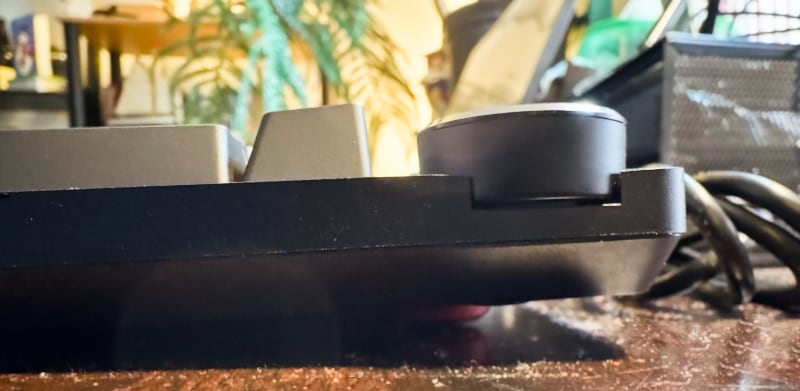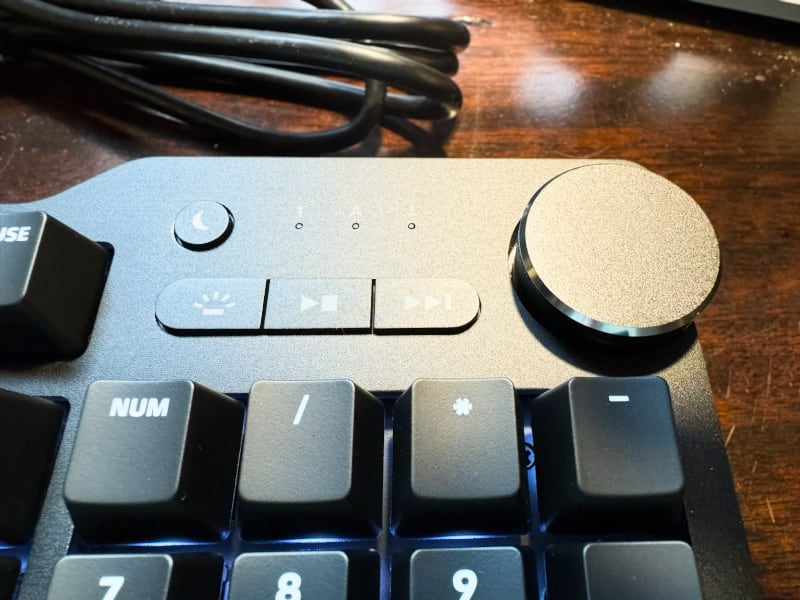
A couple of years ago, Metadot released the Das Keyboard 6 Professional and the MacTigr in short succession. I’ve previously reviewed the Mac-centric MacTigr, and liked it, but what about the more “normal” successor to the Das Keyboard line? Let’s take the 6 Pro for a “test type.”
Metadot was kind enough to once again send one of their keyboards to OFB Labs and I set about to answer that question for someone stuck between the two “flagships.” After all, the two boards are within $10 of each other and both stick with Das Keyboard’s preference for a full-sized keyboard layout with the oft-ommitted number pad. They both sport at least partial aluminum construction and care for detail that’s long been the defining attribute of the company’s offerings.
There are two immediately obvious distinctions between the 6 Pro and MacTigr. On the surface, the 6 Pro is advertised as a Windows keyboard and the MacTigr, unsurprisingly, for a Mac board. The MacTigr also has a lower profile design, with shorter keycaps, whereas the 6 Pro has the traditional height of a mechanical keyboard.
The first distinction is more a matter of convenience than function. These are USB keyboards, so virtually any computer in decades will connect to them. However, a few keys are in different places and others are labeled differently between Macs and PCs, and the respective models target one or the other platform. (More on that in a bit, particularly for Mac users who might miss out on the 6 Pro.)
The second distinction is why clarifying the first matters. Regular versus low-profile boards vary in both aesthetics and typing experience. Arguably, the MacTigr does have a cleaner appearance and its keycaps are about halfway between full height and, say, Apple’s Magic Keyboard. Personally, while I liked the MacTigr and I’m a Mac user, I prefer full-height keys and will take a bulkier look for the sake of those keys. The extra key travel wins the day.
This is a part of the continuing series of TestyTim.com reviews on mechanical keyboards. You can read more, including a summary of what makes mechanical keyboards notable in general, in the review series overview.
The two do share a great deal of family resemblance. Much of what I said of the MacTigr applies to this board too. My summary of Das Keyboard in general, in particular:
As I mused in last year’s review of the Das Keyboard 4 Professional for Mac, the Das Keyboard line has been in the mechanical keyboard game from before it was particularly trendy to do so and surely played a part in restoring the craft of a fine keyboard. Their boards are known for incredibly sturdy builds and an obsessive focus on the typing experience over the bells and whistles.
While no one would accuse Das Keyboard (or most of its competitors) of keeping its lineup of products simple, each individual Das Keyboard is a straightforward product. Skipping the multi-color lighting effects and programmability of Metadot’s foray into such with the Q series boards before it, the current top-of-the-line Das Keyboards feel like the mechanical keyboards Apple would design, imbued with the “courage” not to include the kitchen sink on them.
While the 6 Pro gives up the unibody metal bottom of the MacTigr, the top surface you generally interact with remains aluminum. With the sturdy, and weighty, build of the keyboard, giving up the MacTigr’s metal bottom isn’t a concern.

In some ways, the 6 Professional feels more Mac-like than the MacTigr; for example, it has white backlit keys, something Apple made mainstream long before it was common, while the Mac-focused MacTigr does not. The color of the white backlight is a clean, but not harsh, white much more pleasing than we’ve seen on many boards.
Das Keyboard has always been about a quality typing experience, not glitz. The 6 Pro is both pleasant to use and serious enough looking not to trouble a boss or your home decor. These are designs that are neither stodgy nor native to a gaming den.
Like the 4 Pro and the MacTigr, the 6 Pro is solid without the slightest hint of creaking or movement in the board’s construction. That is why I enjoy Metadot’s keyboards even when I miss a few bells they jettison as superfluous. A finely constructed keyboard is a joy to type on.
This returns us to the reason I would pick the 6 Pro over the MacTigr. While I can type on both reasonably quickly, I could type more rapidly and accurately on the 6 Pro. The greater key travel and shaping of the keys is ideally suited to anyone who is a serious touch typist. Both are superior to a laptop’s uninspired typing experience, but the 6 Pro glories in being mechanical.
For this test, I asked to try it with Cherry MX Blue switches, the standard bearer of “clicky” keyboards. While those needing to get as close to a “quiet” keyboard as possible in the mechanical realm may want to consider the MacTigr, which combines Metadot’s solid construction with red (“linear”) switches to reduce the noise of typing, if you can tolerate — or celebrate — clickiness, do yourself a favor and go with the Blue switched 6 Pro.
Given how good it is, I wish it carried over the MacTigr’s PBT keycaps, the one serious typist’s feature that doesn’t make the transition over to the 6 Pro. Caps made of PBT resist getting the slick sheen to them that the more common ABS ones acquire after regular use. Sadly, only a handful of options exist that combine PBT with backlit (“shine-through”) legends and this model does not add to that list: it trades its sister board’s superior wear resistance for the pleasing aesthetic of backlit keys. Without months of usage, I cannot say how well this particular set of keycaps will hold up, but given the nature of ABS, expect wear to show eventually.
From a connectivity standpoint, the two boards are identical. Like the MacTigr, this board has a fixed, USB Type-C cable and a two-port USB 2.0 Type-C hub on the back. The keyboard came out of the box with the cable already plugged into a USB Type-A (old style) adapter for use with less modern computers, so it’ll work fine on computers new or old. A detachable cable has become commonplace and I’d love to see that here, but at least the included one is amply long and robustly constructed.
Metadot claims the distinction of being the pioneer of the volume control knob on keyboards. The 6 Pro carries on the tradition. Unlike the MacTigr, which I noted inexplicably lacked an accompanying mute button, or the 4 Pro, which had a mute button next to the knob, the 6 Pro lets you satisfyingly click the knob to mute and unmute — much more intuitive.

As a whole, this is an excellent keyboard. As I find myself saying every time I review or use one of Metadot’s boards, I love typing on it. Up against my personal Keychron K6 Pro and Epomaker AK86S, I can type more accurately and comfortably on this keyboard. My recently reviewed Epomaker/Firstblood B67 is the closest in typing comfort and will fit in places the B67’s glitz would be unwelcome.
There are tradeoffs. As I’ve mentioned, the board is not programmable, which most users may not care about, but is an anomaly amongst keyboards whose price flirts with the two century mark. At minimum, it would be nice to see it adopt the common practice of being a cross plaform board with a way to toggle between Mac and PC layouts. While Mac users can go into System Preferences and switch the Command and Option modifier key locations to make the 6 Pro have those keys in the same order that Macs have them, being able to change that on the keyboard itself is simpler and a nearly universal feature on premium keyboards at this point.
Most comparably priced options also sport detachable cables, great if a pet turns the cable into a chew toy, and — beyond that — have a complete lack of need for cables thanks to Bluetooth or 2.4GHz wireless support. If you don’t mind having a keyboard cable running across your desk, this isn’t a big deal, but I’d love to see a “7 Pro” released that adds wireless.
As I said at the end of both the MacTigr review and the 4 Pro review,
Let’s be blunt: these are some real downsides. But, after I considered them, I kept returning to just how nice it is to type on this keyboard. It’s hard to ding a keyboard that is such a pleasure to type on.
This is a typist’s keyboard.
As much as I might feel obliged in a review to note these shortcomings and wish for the day that one Metadot keyboard offered everything I might want, I continue to find myself unusually happy typing on their boards. They just feel really, really nice to this typist’s fingers.
As useful in niche cases as programmability may be, as nice as a slightly cleaner desk with a wireless board is, as much as it isn’t perfect, it nails the core experience. So, once again I’ll commend Das Keyboard’s latest to the serious typist wanting a serious board for serious writing.

I would be remiss to fail to mention one exciting future product on that count: Das Keyboard’s DeltaForce 65, which is in the final stages of development after a successful Kickstarter campaign. I personally backed it because it appears to answer the vast majority of my wishlist for a Das Keyboard; if it ends up slotting in $20 above the 6 Professional, as it appears destined to do, and ends up every bit as nice, or nicer, than past Das Keyboards, it’s going to be great. That said, it does come with its own tradeoff, adopting a gamer aesthetic in lieu of Das Keyboard’s usual elegance. It isn’t for everyone. I hope they eventually offer it in a minimalistic colorway akin to the 6 Pro’s.
When it will be available post-Kickstarter is still unannounced and it certainly wouldn’t fit in an office setting, so that returns us to these current offerings. In the right now, the 6 Pro is perhaps most tactilely compelling keyboard to come across my desk.
Ahead of Prime Day, Metadot is offering OFB readers early access coupon codes on their boards to get $30 off this model using “PRIMEDAY6PRO” and a nice price cut on some of their others. (To be clear, OFB receives no kickbacks or anything of the sort if you use it.) I know of no other keyboard with better construction for the sale price of $169, so if you need a serious, well-built keyboard now, this is a winner (Metadot Das Keyboard 6 Pro; $199 MSRP/$169 on sale, daskeyboard.com).

Timothy R. Butler is Editor-in-Chief of Open for Business. He also serves as a pastor at Little Hills Church and FaithTree Christian Fellowship.
You need to be logged in if you wish to comment on this article. Sign in or sign up here.
Start the Conversation